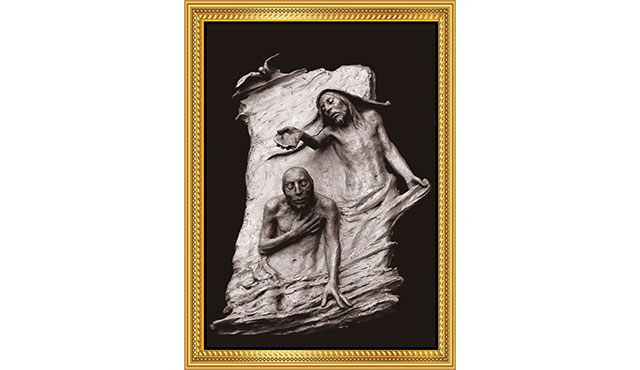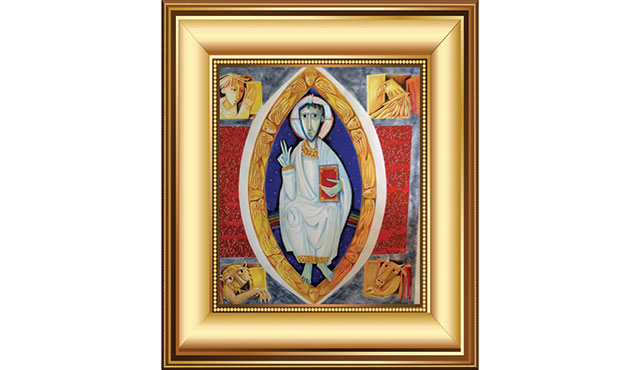The Old Testament begins with the creation of the world. The New Testament begins with the coming of Jesus, the first seeds of Christianity. Faith is rooted in creation.
As such, humankind has honored the Creator, while at the same time acting as His creative conduit through all manner of expression. This includes visual art.
The oldest Christian paintings date to around 70 AD, and the first Christian sculptures, in the form of sarcophagi, date to the early 2nd century. Through the years, Christian works changed: depictions of objects, people and events evolved into expressions of religious meaning. Christian art – the Sistine Chapel and “The Last Supper” are but two examples – thrived despite the secularized Renaissance. The last half-century has seen a concerted effort by Christian artists to create sacred works that proclaim their faith in Christ, God and the Church.
Some stunning new examples of contemporary sacred artwork – bronze sculptures, mosaics, a spectacular tapestry and much more – have been commissioned and will adorn Christ Cathedral when the refurbished house of prayer is dedicated on July 17, 2019. All beautiful and important, these works will serve as a sign and source of faith for years to come, thanks to the efforts of gifted artists, the Diocese’s Sacred Arts Commission, generous donors and the Orange Catholic Foundation.
Part of the Catholic cathedral’s renovation project, the commissioned artwork wouldn’t have been created without funds provided by big-hearted donors who gave to the Orange Catholic Foundation. For this reason, “We’ll have a donor wall that will include the names of those who gave large gifts for this purpose,” says Tony Jennison, the Orange Catholic Foundation’s vice president of philanthropy and a member of the Diocese’s Sacred Arts Commission and the Cathedral Construction Advisory Committee.
The cathedral’s artworks will include, among many others:
• A crux gemmata, made of a bleached- or white-cedar image of Christ, suspended over the altar table
• Two bronze bas relief works that depict the manifestation of the Lord’s divinity in the Scripture: the Adoration of the Christ Child by the Magi, the Wedding Feast of Cana, the Transfiguration of the Lord on Mt. Tabor, and the Baptism of the Lord by John the Baptist
• 14 Stations of the Cross, also created in bronze bas relief to be in continuity with the four manifestations
• 12 dedication lights suspended from the cathedral’s interior walls, each representing the 12 Apostles
In addition, stunning works in mosaic – a medium used in early Greek, Roman and Christian art – will adorn the cathedral.
“Two floor mosaics will be located in the Narthex [the cathedral’s entry area],” Jennison says. “They’ll depict two coats of arms: one for Pope Francis and one for Bishop Vann.”
The Diocese’s patroness will also appear in mosaic. “The Our Lady of Guadalupe piece will be located on the cathedral’s south interior wall,” Jennison says.
A vibrant tabernacle will inhabit the round Blessed Sacrament Chapel. “The piece was originally commissioned for a convent, but it didn’t make it there,” Jennison says. “It wasn’t for sale, but Msgr. Arthur Holquin and Brother William Woeger reached out to the family of noted German artist Egino Weinert and negotiated to acquire it.
“The tabernacle and the mosaics are all very vivid,” Jennison says. “These works will really stand out and ‘pop.’”
Another work that will surely pop, a multicolored 35-foot tapestry depicting Jesus, will be suspended from the architectural space frame on the north side of the Cathedral’s interior. “The tapestry’s artwork itself is done,” Jennison says, “but I’m not sure if the looming process is finished; it’s probably close.”
Visual beauty is but one way the faithful remain devoted, Jennison says. “Everybody experiences God’s love in different ways. Worthy, sacred art is important to tell the story of Jesus and the Bible, and to remind us why we’re all here.”


